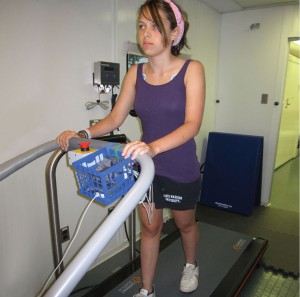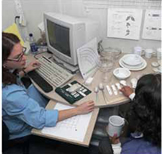New Survey Measures the Fitness of America’s Youth
Posted on byThe NHANES National Youth Fitness Survey (NYFS), conducted as a separate survey alongside the National Health and Nutrition Examination Survey (NHANES), is receiving an enthusiastic response from its young participants.
For the NYFS team in the Division of Health and Nutrition Examination Surveys, attaining good response rates is critical to the program’s success. The NYFS, funded in 2011 through the Affordable Care Act (ACA), has received funding for the 2012 survey year only.
The NYFS was added to the NHANES program in response to the need for data on physical fitness in children and teens. The NYFS collects data on exercise and nutrition habits of U.S. children ages 3 to 15, through interviews and fitness tests conducted in a dedicated mobile examination center (MEC) trailer. A team of four (two exercise physiologists and two nurse practitioners, all with extensive pediatric experience) administer the fitness tests, which take one and a half to two hours to complete, depending on age.
The NYFS is a model of comprehensive youth-targeted fitness and nutrition data collection, an accomplishment made all the more remarkable given the tight time constraints under which it was created. The NYFS team had just eight months to design the new survey, and take it on the road.
The last time a national survey with physical measurements of youth fitness was conducted was 25-plus years ago: The Department of Health and Human Services’s National Children and Youth Fitness Study I with ages 10-17 years in 1984, followed by the National Children and Youth Fitness Study II with ages 6-9 years in 1987.
America’s youth have undergone significant changes in the 25 years since the last survey. An entire “supersize” generation has appeared. According to Let’s Move!, First Lady Michelle Obama’s initiative dedicated to solving the problem of obesity, nearly one in three children are overweight and one in six are considered obese, based on data from NHANES. This has profound implications for public health policy now and in the future, and drives the need for accurate, comprehensive data on the current state of American youth fitness.
The new NYFS directly addresses current physical activity levels and nutrition habits through in-depth questionnaires and tests. The participants are selected from the same locations as NHANES, but they are chosen from a separate sample. Children who participate in NHANES, or belong to a household with NHANES participants, are excluded from the NYFS. Participants are chosen based on age and sex, and take part in an in-home interview that includes a physical activity questionnaire prior to coming to the mobile examination center (MEC).
The heart of the survey is the MEC trailer–a 48-foot-long fitness center designed to collect an extensive range of physical activity data. Ten fitness components are housed in the wheelchair-accessible trailer. The children and teens arrive at the exam dressed in shorts, tee shirts, athletic shoes and socks (although the trailer stocks an assortment of athletic shoes in all sizes in case participants arrive unprepared). Inside the trailer, body measurements are taken, and then activity reigns supreme.
The most recognizable component is a treadmill, which is used to assess maximal endurance in 6 to 11 year olds and aerobic capacity in 12 to 15 year olds. The endurance test, developed in consultation with a pediatric cardiologist, is very popular with the younger children, who are asked to walk and then run until they can’t run anymore. They finish the test exhausted, but smiling.

At the other end of the familiarity scale is “The Chair,” a custom-designed device created to measure lower body muscle strength in 6 to 15 year olds. Participants are allowed to use only their legs and lower bodies in this challenging test, and often call this their favorite exam.
A 24-hour dietary recall interview is conducted with parent and participants, as appropriate for age. The survey also gathers data from the physical activity monitor (PAM), a tri-axial accelerometer that children wear on their wrists to measure body movement for seven days and nights, which is then returned via mail.

Staff from the CDC Division of Nutrition, Physical Activity, and Obesity worked with NHANES on proposed physical activity and fitness tests, and provided questions for the physical activity questionnaire. When the NYFS team was developing activity and fitness tests for the youngest children, 3- to 5-year-olds, they found that there were few standardized tests to assess fitness in this age group.
Their solution: the Test of Gross Motor Development, version 2, or TGMD-2. The TGMD is the gold standard for gross motor skills assessment, used worldwide, and fit perfectly into the NYFS’s objectives. The TGMD comprises a total of 12 tests. Six measure locomotor development: participants run, gallop, slide, leap, hop, and jump horizontally. The remaining six tests assess object control, as participants roll, toss, dribble, catch, bat, and kick a ball.
The fitness data from the NYFS, anticipated in the Fall of 2013, will be the first from a national survey on measured youth fitness in decades, and will set an important baseline for future studies and public health policy decisions.
Posted on by

